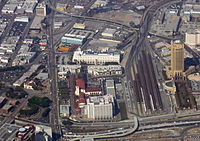
Photo from wikipedia
Taxi trips have been somewhat neglected in transportation mobility and multimodal connection studies. The socio-demographic characteristics of taxi riders are often not fully revealed and the relationship between the taxi… Click to show full abstract
Taxi trips have been somewhat neglected in transportation mobility and multimodal connection studies. The socio-demographic characteristics of taxi riders are often not fully revealed and the relationship between the taxi and fixed-route public transportation has not been sufficiently quantified. This research operationalizes the multifaceted relationship between the taxi and transit in an innovative way. We categorize taxi trips into three types: transit-competing, transit-complementing, and transit-extending trips, by examining the spatial relationship of taxi trips’ origins/destinations and the locations of transit stations using a New York global positioning system taxi trip dataset. The distinct characteristics of the three types of taxi trips reflect the different market segmentations that taxis serve and the competing, complementary, and supportive nature of the relationship between the taxi and transit. We also explore the demographic characteristics of taxi riders and the result reveals the important role of taxis in providing mobility options to the economically or physically challenged population. Among our many findings are that transit-extending taxi trips have significantly shorter average trip lengths and larger proportions of people paying with cash than other trip types. These and other results point to important policy implications for improving the multimodal connection between the taxi and transit.
Journal Title: Transportation
Year Published: 2019
Link to full text (if available)
Share on Social Media: Sign Up to like & get
recommendations!